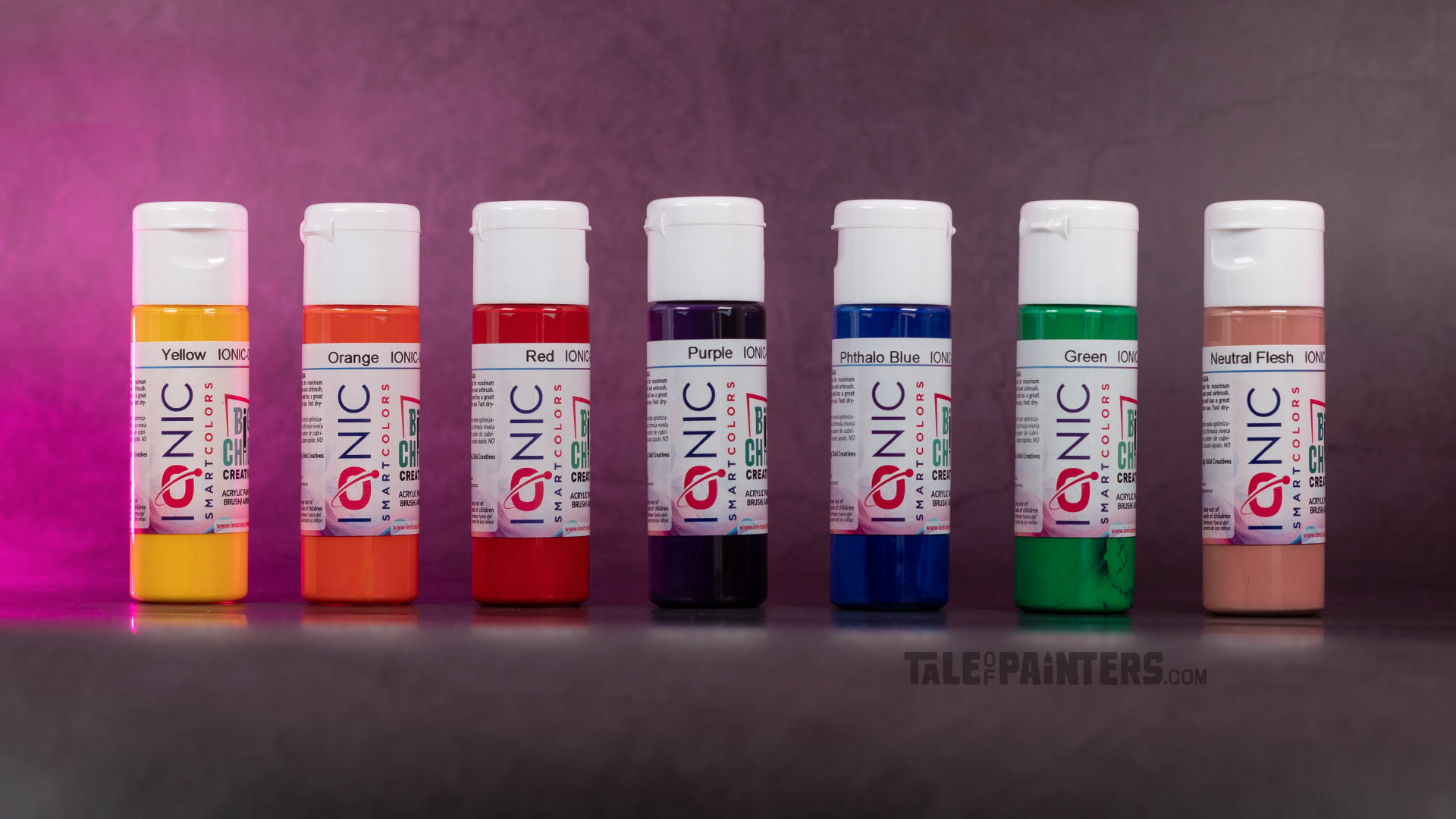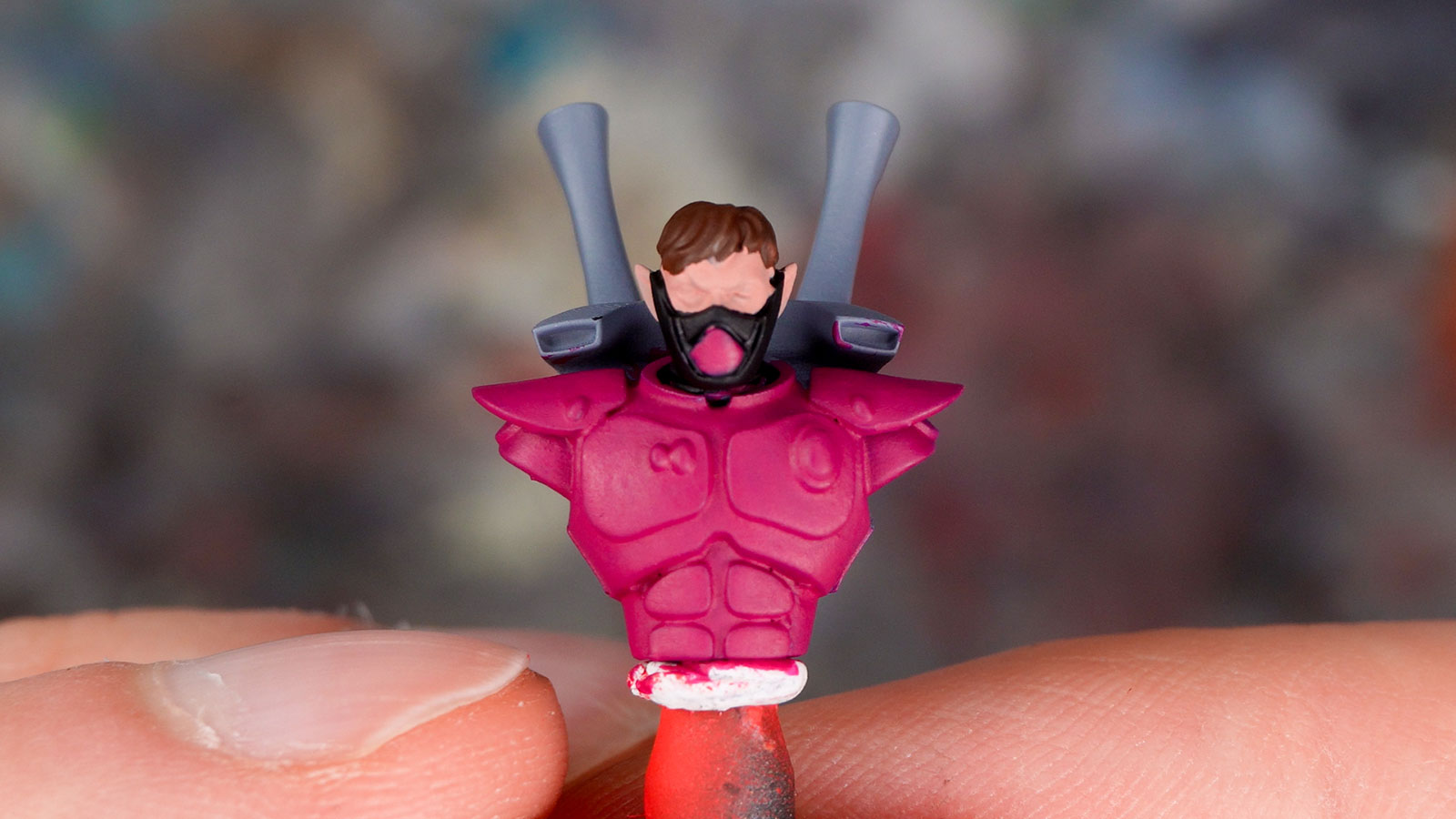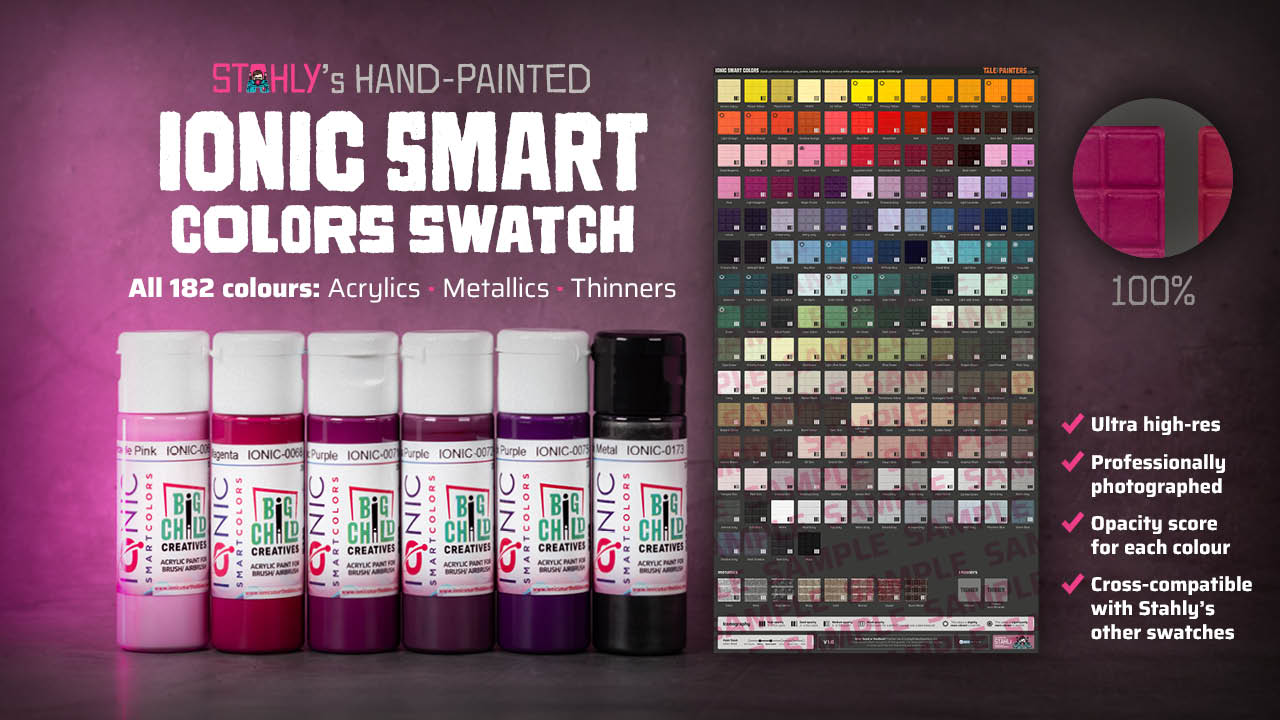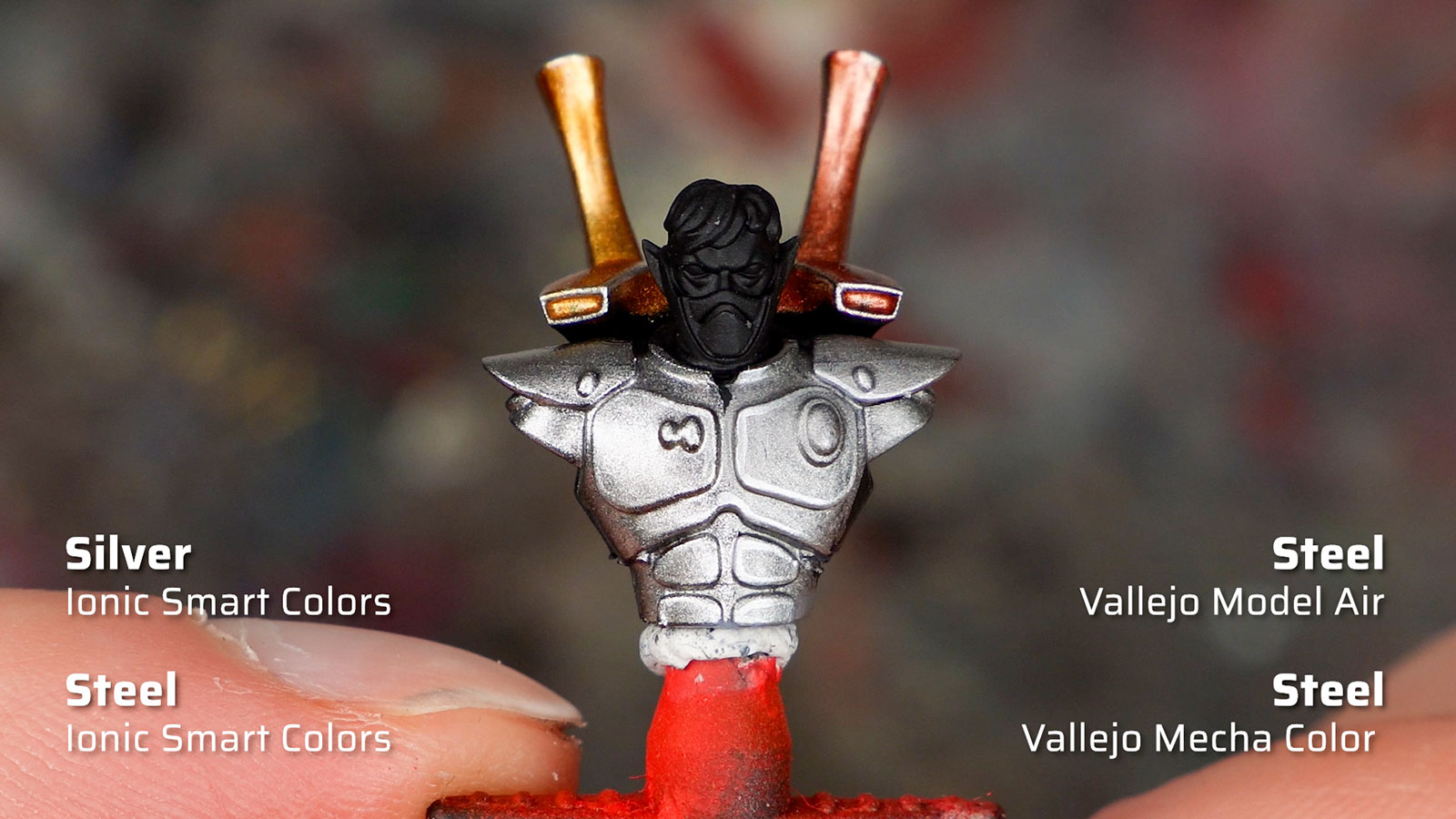In recent years, we’ve seen a surge of new and impressive paint ranges, each claiming to outdo its competitors. This leaves me wondering: can acrylic paints for modelling improve further, or have we hit the ceiling? Big Child Creative also pondered this question, and their answer is their new Ionic Smart Paint, which you may have already seen in videos by Ninjon and Vince Venturella with their development name “Atom Smart Paints”. For this review, I tested the entire range with all 180 colours to explore whether Ionic represents the next evolutionary leap in miniature painting and the role that the Citadel Colour range of the 2000s plays in all of this.
I’m a total paint nerd, and I believe that high-quality paint makes painting miniatures easier, faster, and more fun. That’s why I’m always on the hunt for the next big thing, and maybe that could be Ionic. This new paint range was developed by Big Child Creatives in close collaboration with Ammo MIG. Big Child Creatives is a Spanish studio of industry experts and professional painters, and Ammo is a well-known brand in the scale modelling community. After 4 years of development, the Ionic paints were initially slated for a Kickstarter launch as ‘Atom Smart Paints’, with prototypes featured on Ninjon’s, Vince’s, and Lyla Mev’s YouTube channels in 2024. To avoid confusion with Ammo’s existing ‘Atom’ range, they were renamed ‘Ionic Smart Paints’. They also skipped the Kickstarter, and all 180 paints are now available, for example on the Ammo and Big Child Creatives websites, and in more and more hobby shops.
Watch the video:
What’s so special about Ionic?
But what’s so special about the Ionic range, and why are professional and competition-level painters so excited about them? Well, Ionic promises a groundbreaking formula that combines high covering power without sacrificing saturation.
Why is this so special? You know, most of the recently released ‘new generation’ paint ranges, such as Warpaints Fanatic and Two Thin Coats, focus on high covering power. This is achieved by adding opaque pigments like white and grey, but this can bring the vibrancy down. For the most saturated, perfectly mixable paints, you’d usually need to go for single-pigment artist paints like from Kimera or Golden, but they can either be quite thick, transparent, and/or hard to use. Ionic paints claim to give you the best of both worlds: super vibrant and pure colours that are as easy to use as you would expect from miniature paint.
Sounds too good to be true? Well, I’m going to give them a try. I have all 180 colours here, as well as Ammo’s Atom paints for comparison.


Testing the Ionic range
Now, Ionic paints come in these unique 20ml containers that are the same size and diameter as standard dropper bottles, so they will fit into existing paint racks. The bottles have agitators and a combination of flip-top and dropper lid. This works quite well, only problem I’ve had was the angle of the lid sticking up and smudging paint on my wet palette.
Paint behaviour
Ionic doesn’t need much shaking, and the paint is pretty thick and rich, a little gel-like I’d say, so you definitely need to thin them down. They have excellent self-levelling properties though, so if you apply a bit too much, it’s not the end of the world. But once you’ve added a little water, they apply really well, working and drying time is a bit longer than average, similar to Two Thin Coats I’d say. For this review, I’ve tried all 180 colours, and the paint texture is consistent and smooth across the range, in this regard they’re one of the most consistent paint ranges I ever reviewed. Also, Big Child Creatives claim that the paint is self-lubricating, meaning it doesn’t separate on a wet palette, or at least not as quickly. And yes, the paint does last quite a long time without separating. Separation on a wet palette is a problem that many new-generation miniature paints have, like Vallejo Game and Model Color, which separate on wet palettes within minutes.
Okay, let’s give one of the vibrant colours a try. As you can see in the video, the magenta is super vibrant and rich, in real life even more than on camera. The covering power is surprisingly decent considering the pureness of the colour, and the finish is very matte when fully cured. You’ll still need about 3 to 5 thin layers for the magenta, as they’ve gone for really pure pigmentation and haven’t added any opaque pigments like white or grey. Some of the other bright paints like yellow and orange are even more transparent and might require more layers. A lot of the primary colours are indeed single-pigment paints, so they keep their luminosity when you mix them. Most miniature paints are made up of a combination of several pigments, which means they usually become a bit greyish or brownish when you mix them.


However, the Ionic range is not just limited to vibrant colours. There are also some more muted colours in the range that provide even coverage in two thin coats, like this skin tone here. So the range covers both ends of the spectrum. I also found that their white and whitish paints are fantastic, good covering power for white and they go on super smooth without a chalky finish.
Glazing, blending, drybrushing, airbrushing
Alright, let’s do some more tests. In the video I’m thinning a purple with water to create a glaze and applying it to my little Stahly demo model, which works great. Thanks to the longer drying time, wet blending also works well, though I have to admit I’m not the best wetblender in the world. I’m better at doing edge highlights, and even though painting for the camera is always a bit more difficult, I got along great with Ionic paints. With a bit of water or thinner, the paint has the ideal flow properties for edge highlights. When undiluted straight out of the bottle, Ionic is ideal for drybrushing thanks to its rich consistency.
Last but not least, the airbrush test, and here I was struggling a bit in the beginning. The rather thick consistency required a lot of thinner, and initially the spray pattern had a lot of splatter as paint on the tip dried quickly. Then I switched from my go-to Vallejo Thinner and Flow Improver mix to the Ionic thinner. There are two of them in the range and I chose the one with the additional retarder. With this, I achieved a finer atomization and smoother result. However, if you’re looking for a paint range specifically designed for airbrushing, I would recommend Ammo’s Atom paints instead, about which I talk below, or Vallejo Game Air or Warpaints Air from The Army Painter.
The Ionic colour palette
So far so impressive, now let’s take a look at the selection of colours. There are 180 colours in total, including two thinners and 8 metallic paints. The Ionic palette must have been put together by real paint nerds, because many of the colours are inspired by the old Citadel range from the 2000s. Just look at some of the names: Blazing Orange, Scab Red, Enchanted Blue, Scaly Green, Graveyard Earth – and they’re all pretty close matches to the classic Citadel paints from that era. They’re not always 100% spot-on – the Ionic Blazing Orange isn’t quite as vibrant as the Citadel version for example – but some colours, like Magenta, are a perfect match. And they’ve even included the classic Goblin Green from the 90s! If you want to know more about the Citadel Colour range from the 2000s, check out this link, I made a retro review about them.
But Ionic isn’t just a mirror image of the old Citadel range, in fact, the way the palette is put together is more akin to AK 3rd Gen or Vallejo Model Color. That means no triad system or similar guideline to help you get started. Instead, they throw a bunch of colours at you and you need to figure out yourself what goes together. There is a list in the Ionic flyer, but it’s not super accurate and has a lot of colours which look very similar. So If you don’t want to go through trial and error, I recommend checking out my hand-painted swatches to avoid any blind buys.


This hand-painted swatch is available in my Patreon shop for a small donation (or by becoming an Autarch tier member). I also have swatches for Pro Acryl, AK 3rd Gen, Vallejo Game & Model Color, Citadel Colour, and more – all cross-compatible with each other so you can compare colours across different brands. Check out my shop for details.
I’ve professionally photographed all the major paint ranges by now, both as individual swatches and in a large 7-in-1 document with over 1100 colours. And of course, I’ve also digitised the entire Ionic range. You’ll get two swatches, one sorting all 180 colours according to the product list and a second, in my opinion more useful version sorted by colour family, hue, and saturation, so you can see at a glance which colours go together.
Ionic vs Atom paints comparison
Before I dive into testing the metallic paints, I would like to briefly explain how Ionic differs from Atom paints. The Atom range is made by Ammo MIG, the same company behind Ionic, and they share the same container shape. The colour ranges are almost identical in terms of selection and size, although colours with the same name aren’t always exact matches. Both ranges have a very similar feel and formula, but Ionic is thicker and better suited for brush painting, while Atom is designed for airbrushing. The consistency of Atom is a bit thinner, but still needs to be diluted slightly before you can pour it into the cup. Atom is also water-based and non-toxic, but it sprays as smoothly as lacquer-based paints and is particularly resistant to lacquer- and enamel-based weathering products. However, Atom can also be applied well with a brush, so we’re talking about nuances.
The metallics are… something
Alright, let’s get to the metallics finally. Unfortunately, there are only 8 of them, but what they lack in quantity, they make up for in quality. They behave a bit differently from the regular Ionic acrylics though. First of all, you need to shake them really well, as they tend to separate quickly. Unlike the acrylics, they even separate pretty fast on a wet palette. But you’re rewarded with excellent coverage; the gold covers black in just two to three thin coats. And the finish is truly spectacular.


As you can see in the video and photo, the finish is very shiny and glittery. There is also a comparison with Vallejo Mecha Color silvers. Those have finer metallic particles, cover even a bit better, but they’re also duller. Which one you prefer is a matter of taste, but if you like lots of sparkle and shine, then there’s little that can beat the Ionic metallics, maybe Turbo Dork.
However, the quick separation is a bit of a downside. I even had some spots on my model, like this copper area here, where I got some slight mottling. I recommend using Ionic’s thinner instead of water to dilute the metallics, as it helps to keep the pigments together a bit better, and applying multiple thin layers.
Value
Ionic Smart Colors have a single price of approximately €3.50/€3.60 per bottle. This is more than fair given the high quality and large volume of 20ml (2ml more than Vallejo, 3ml more than Warpaints Fanatic and AK, and 8ml more than Citadel). The paints are currently available on the Ammo and Big Child Creatives websites, as well as in more and more hobby shops. So ask your LGS or check out our partners, PK-Pro already have them in their range:
You can find the latest hobby products at our 🇬🇧/🇪🇺 partner stores Wayland Games, Element Games, and Firestorm Games, at 🇩🇪 Taschengelddieb and PK-Pro, and at 🇺🇸 Noble Knight Games with a welcome discount of up to 10 – 15% over RRP. Using our links helps to support Tale of Painters at no additional cost to you, so thank you very much for using them!
I hope you found this review helpful, feel free to leave a reaction or comment below, or post your questions here or discuss on our Discord channel.
8.5 Score
Pros
- Highly saturated colours, matte finish
- Very consistent and smooth consistency across the range
- Don't separate on a wet palette quickly
- Each bottle contains 20ml of paint for a fair price
- High shine metallics
Cons
- Sacrifice a bit covering power for saturation
- Metallics separate quickly
Final Verdict
In total, the Ionic range gets an excellent 8.5 out of 10, however, I wouldn't recommend it to everyone. Why? Well, I believe the target audience is more advanced and professional painters. If you want extra vibrant colours and are willing to sacrifice a little covering power, then Ionic might be the perfect addition to your collection. And/or if you loved the Citadel paints from the 2000s with their vibrant colour palette but prefer a more modern, updated formula, then these are worth a look as well. However, if you're new to the hobby, or if you want to make painting as efficient as possible with less coats needed to put on your models, then I would recommend other paint ranges instead. For example Warpaints Fanatic and Two Thin Coats. They have a triad system that makes them easy to navigate, and while their colours aren't as super vibrant as Ionic, they cover much better, even with tricky colours like yellow.








